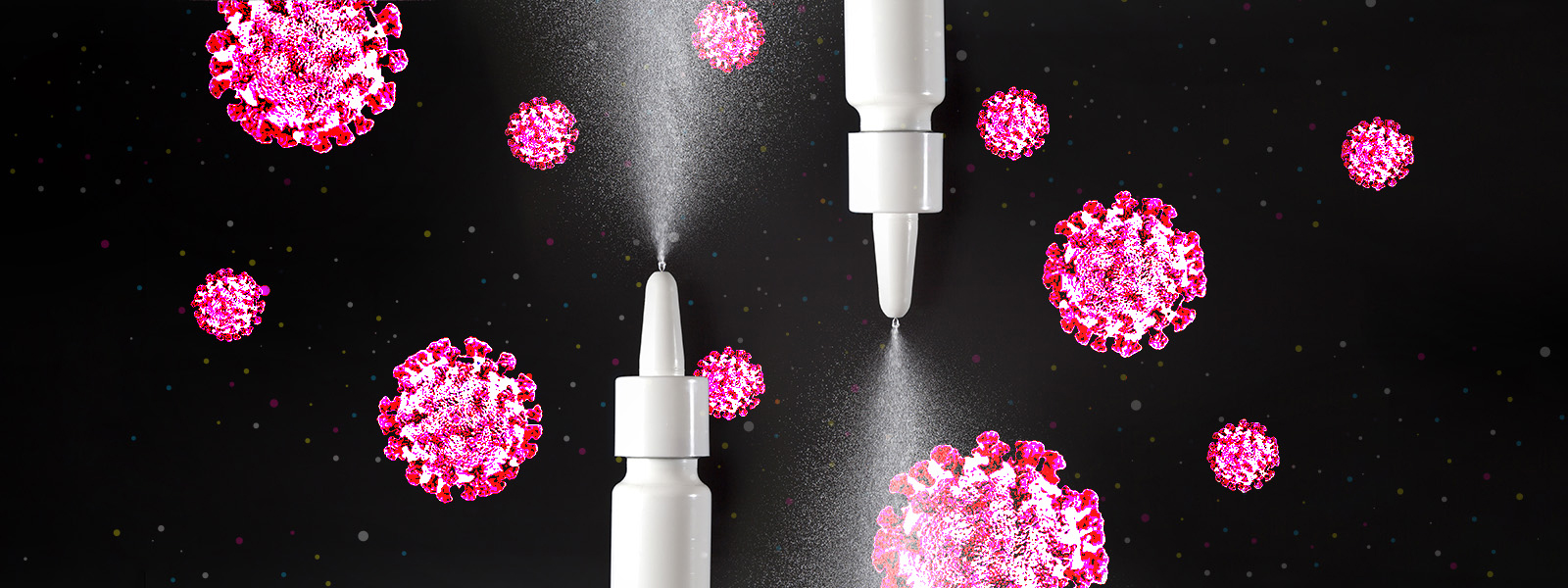
What next-gen Covid-19 vaccines might look like
Nearly two years after the advent of vaccines against Covid-19, the pandemic is still, frustratingly, with us. The vaccines have done an excellent job at their primary mission, preventing severe disease or death. But they haven’t been as effective at keeping people from catching and spreading the virus — partly because SARS-CoV-2 has become more contagious, and partly because it is evolving to dodge the vaccines.
That’s why experts are excited about a crop of novel vaccines now under development. All require more testing before they’re ready for use in people. But if they perform as hoped, some of them will be much better at stopping the virus from spreading. Others could provide lasting immunity toward many different strains of the virus — and possibly toward a wider range of coronaviruses, perhaps including some found in animals that are likely candidates for the next emerging disease. Still others could make vaccinations more convenient — and improve vaccination rates — by delivering multiple boosters in a single injection.
Here’s what’s on the vaccine horizon:
Live-attenuated vaccines
One way to build a more effective vaccine is to give the immune system more to chew on. The Covid vaccines currently in use train the immune system to recognize and attack just a single part of the virus: the spike protein on the virus’s surface. That has proved problematic, because the spike protein mutates easily, and newer variants aren’t attacked as forcibly by an immune system trained to recognize older forms of the protein.
Using the whole, live virus — weakened so it can no longer cause disease — may work better. “A live vaccine mimics the virus. It’s like you’ve had Covid, but you don’t get sick,” says Robert Coleman, a virologist and CEO of Codagenix, a biotech company in Farmingdale, New York. “Not only are you making antibodies to the spike but to all the other proteins of the virus, and you’re making immune cells that recognize the proteins.”
Such live-attenuated vaccines have been around for many years, and include the familiar, highly effective chickenpox, smallpox and measles/mumps/rubella vaccines. But until now, the only way to produce a weakened virus has been to laboriously infect cultured cells, generation after generation, selecting the least pathogenic viral lineages each time. That’s time-consuming and runs a slight risk that the virus could later mutate back to a more aggressive form, which is a rare complication seen with the old oral polio vaccine.
Codagenix avoids that labor and risk by exploiting a quirk of the genetic code. The genome of every organism, including viruses, uses three-letter “words,” or codons, to specify which amino acid to add next when building a protein. Usually, several different codons can specify the same amino acid — and cells such as our own are more adept at using some codon sequences than others.
Codagenix takes advantage of this by deliberately swapping in less-favored codons at 283 different spots in the viral genome. Each individual change has only a tiny effect, but together they slow viral replication to less than 10 percent of normal — enough that the host’s immune system can keep the virus from causing disease. “It’s death by a thousand cuts,” Coleman says.
Yet the weakened virus produces exactly the same proteins as wild SARS-CoV-2, thus generating a protective immune response. And with 283 different changes to reverse, Coleman says, the chance that the virus could revert to a more pathogenic form is nearly nil.
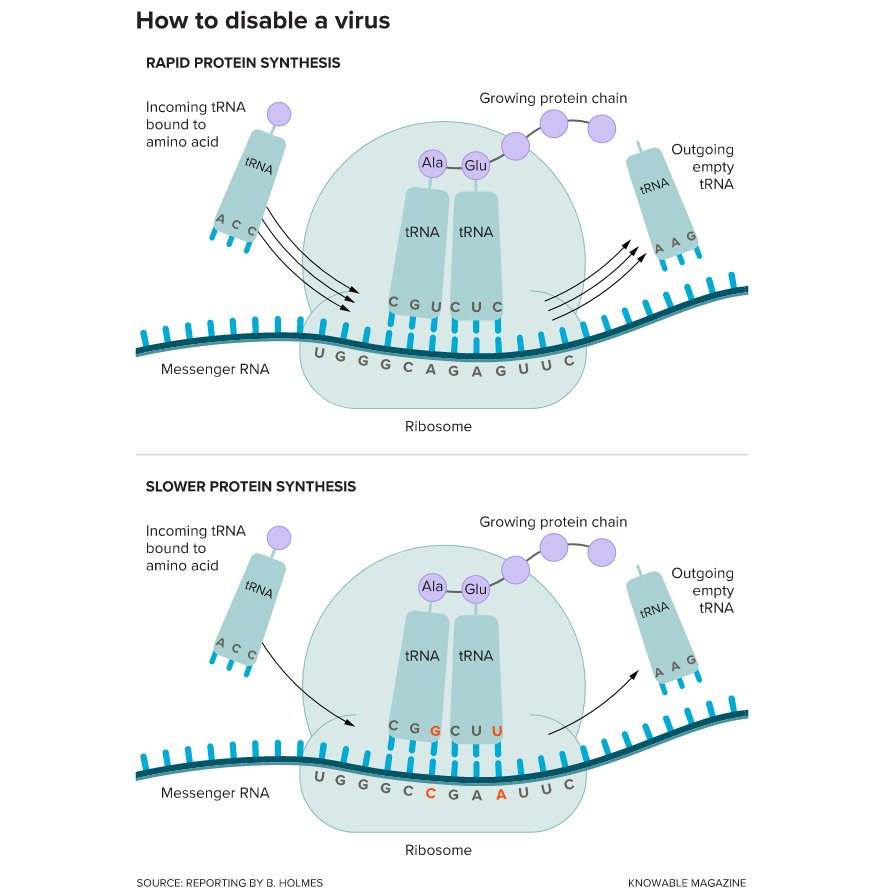
In early-stage human trials that measured the ability to trigger antibodies and immune cells, the Codagenix live-attenuated vaccine, given as nasal drops, produced a strong response with good safety. And, promisingly, volunteers who received the vaccine in mid-2021 — before the emergence of the Omicron variant — produced immune cells that recognized and attacked Omicron, even though they had never been exposed to it. This suggests that the Codagenix vaccine produces a more broadly protective immune response than other vaccines, presumably because it offers more points for the immune system to recognize, says Coleman.
The company has just begun the final stage of testing, a phase 3 clinical trial in up to 20,000 people, and vaccine experts such as Jerome Kim, director general of the International Vaccine Institute in Seoul, South Korea, are watching with interest. If all goes well, the vaccine should be ready for market sometime next year, Coleman says.
Needle-free vaccines
Most people dislike getting a needle in their arm, so the idea of getting a vaccine in a puff of nasal spray sounds attractive right away. But intranasal vaccines have an even bigger advantage. It turns out that they may also be better at preventing respiratory viruses from spreading between people.
That’s because presenting a vaccine to the soft, moist tissues of the nose and airways — the mucosa — induces a different kind of immune response, one that’s concentrated not in the bloodstream but in the mucosal tissues themselves, where the virus that causes Covid enters the body. Immunologists don’t fully understand this mucosal immune response yet, but they hope that by gathering defenses at the virus’s point of attack, the body may neutralize the virus before it can cause an infection, rather than just reducing an infection’s severity.
“If you’re at a nightclub, you have security guards inside that keep people in order, but you also have bouncers outside to keep unruly people from entering in the first place,” says Jen Gommerman, an immunologist at the University of Toronto who studies mucosal immunity.
The mucosal immune response — the bouncers — seems to involve a two-pronged approach. Immune cells (B cells, T cells and others) trained to recognize an invader concentrate in mucosal tissue where they can defend the perimeter. But in addition, some of the B cells secrete an unusual class of antibody, known as IgA, into the mucus layer on the surface of the airways where they can act like bouncers.
The more familiar antibodies that dominate in the blood — the inside guards, known as IgG — are roughly Y-shaped, with each arm of the Y able to grab onto a recognition point, or antigen, on the virus. An IgA, in contrast, comes in pairs stuck together at the base of the Y. “It looks like a dog bone,” says Gommerman. “Instead of two binding sites, it’s got four.” That’s one reason IgA should be better able to latch onto viral antigens before the virus enters cells of the body, she says.
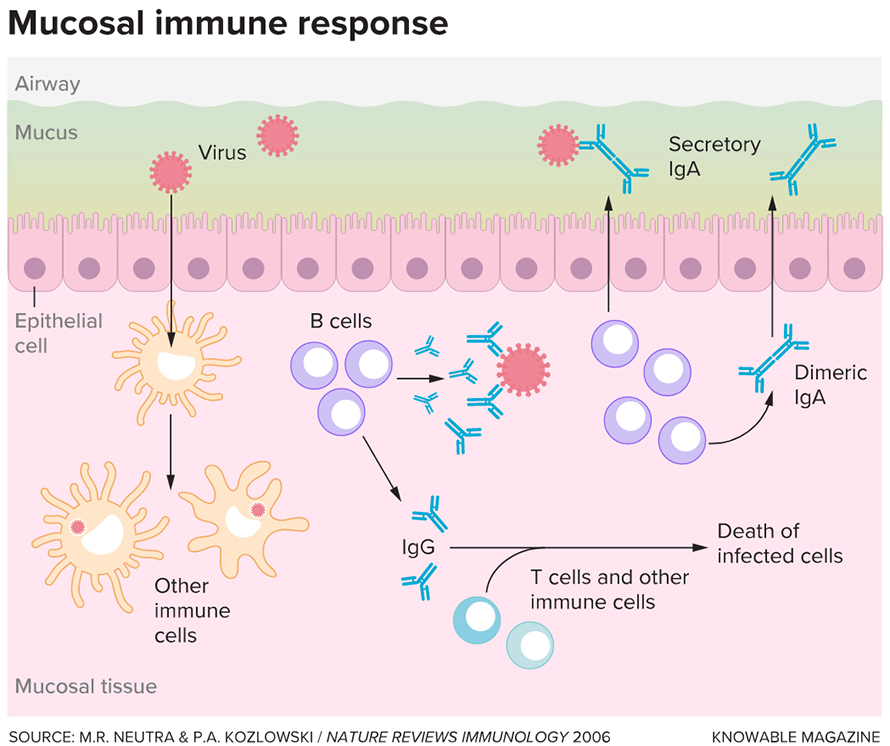
Ordinary vaccines given through a needle aren’t good at producing mucosal immunity — but natural infections are. In one recent study, for example, researchers compared 10 people who were recovering from natural Covid infections and 19 volunteers who had received standard intramuscular vaccines. The former group had significantly more anti-Covid IgA antibodies in their airways, the scientists found, though the study did not show that this translated into better protection.
That sounds promising, but nasal vaccines face formidable technical challenges. The mucosal tissues of the airways are built to repel invaders. A nasal vaccine would have to penetrate the slimy mucus layer lining the airways before it could enter the body, while intramuscular vaccines bypass those defenses with a needle.
One solution is to use live viruses in the vaccine, as Codagenix does, since they have evolved to evade host defenses. But live-attenuated vaccines can be risky for people with weakened immune systems.
Another way around the mucosal defense problem could be to use a nasal vaccine as a booster after initial doses of standard intramuscular vaccines. The shots in the arm don’t produce a strong mucosal response themselves, but they would prime the immune system to respond vigorously to even tiny quantities of the booster that get past the mucus, says Akiko Iwasaki, an immunologist at Yale University who wrote about mucosal immunity in the 2016 Annual Review of Immunology.
Iwasaki’s team has tested this in mice, using a single injected priming dose of mRNA vaccine (the familiar Pfizer vaccine in standard use today). Then they followed it up with a nasal booster consisting of SARS-CoV-2 spike protein, instead of an injected second dose. The approach generated high levels of mucosal antibodies and immune cells, her group found, whereas two intramuscular doses of the Pfizer vaccine produced only the normal, blood-borne response. The nasal booster also better protected the animals against severe disease.
The biotech company Vaxart is testing another mucosal vaccine — this one given in pill form, another way of inducing mucosal immunity — against the Covid virus. In early clinical trials, the vaccine generated antibodies against SARS-CoV-2, especially when given as a booster after a standard mRNA vaccine. Best of all, the immunity seems to cover a wide range of Covid variants, including Omicron, that standard vaccines are less effective against.
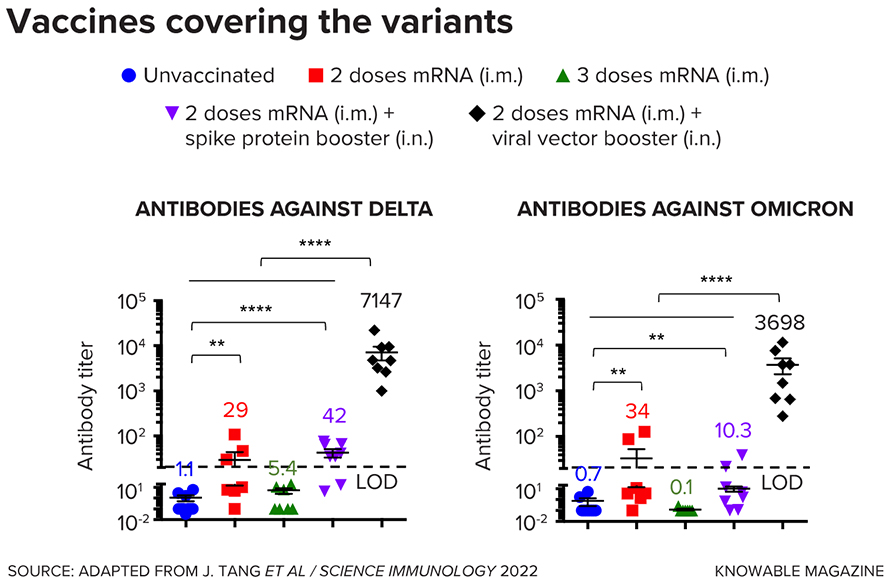
In theory, the antibodies from this mucosal immune response should block viruses from entering the body, and it could also capture viruses as they are being shed by infected cells. Both should reduce the rate of viral transmission.
However, no studies have directly verified this so far for any respiratory virus. And people previously infected by Covid-19 can still get reinfected later, so natural mucosal immunity is clearly not enough to block transmission completely, says Maria Elena Bottazzi, a vaccine researcher at Baylor College of Medicine and codirector of Texas Children’s Center for Vaccine Development. Moreover, one attempt at nasal vaccination, using AstraZeneca’s version of the Covid vaccine, failed to provide immunity in a clinical trial, researchers announced in early October.
On the other hand, volunteers who received the Codagenix live-attenuated nasal vaccine had no detectable virus in their airways after their second dose, says Coleman. Since the vaccine itself delivered live viruses to the nose, this suggests that airway cells infected by the vaccine virus were not shedding much.
Nasal vaccine technology is still relatively new, and researchers may find ways to enhance the effects. “There’s still a lot to do to understand mucosal immunity,” Bottazzi says. “We haven’t seen any mucosal vaccines that have been stellar — but that doesn’t mean it’s not going to work for coronaviruses.”
Broad-spectrum vaccines
In the last two decades, three serious coronavirus diseases have emerged in the human population: SARS in 2002-03 and MERS in 2012 — both of which fizzled — and Covid-19, which caused a global pandemic. Public health experts say that there are more coronaviruses coming. And so vaccine researchers are working hard to come up with broad-spectrum vaccines that could protect against a wide range of known and unknown coronaviruses, including those that caused the SARS and MERS outbreaks. Even if they’re not perfect, such vaccines could also help tame new variants of SARS-CoV-2, which have proved better at evading current vaccines.
“Coronaviruses are still going to be out there, so we need to look for strategies that broaden protection,” says Bottazzi.
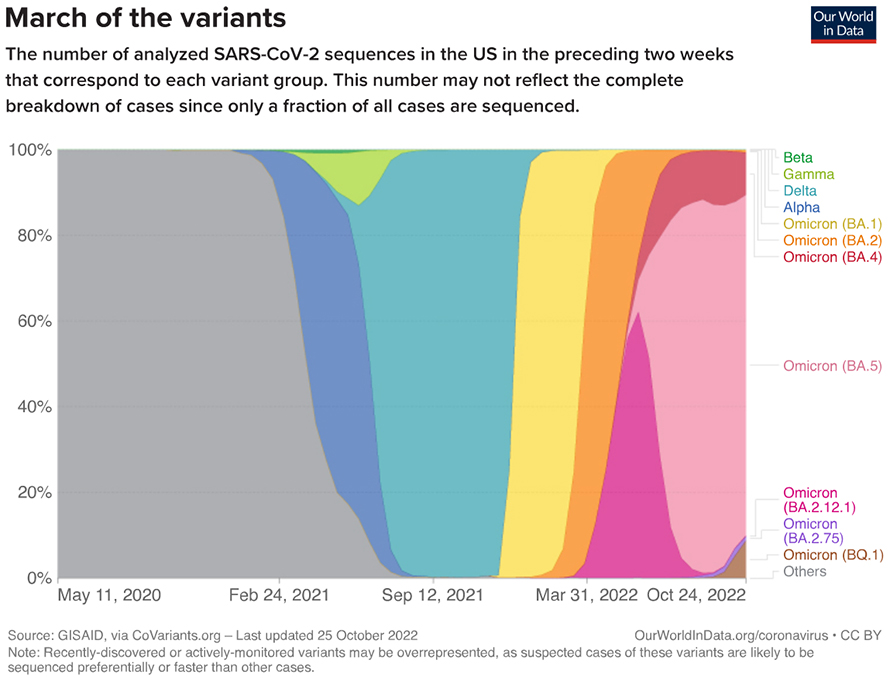
One way to build a broad-spectrum vaccine is to collect antigens from several different coronaviruses and combine them into a single vaccine. In its simplest form, that’s what the recently approved bivalent Covid vaccine does, by combining spike proteins from the original virus and the Omicron variant to make a shot that responds to both.
Pushing this approach further, virologist Ralph Baric of the University of North Carolina is building synthetic spike proteins that combine parts from as many as three different sarbecoviruses — the subset of coronaviruses that includes SARS and Covid viruses, and some potentially nasty viruses of bats and other animals. Baric hopes to create a vaccine that protects against all three. A second dose — built from three other coronaviruses — could extend coverage still further against current and future threats such as MERS. He’s testing the strategy in animals now, in partnership with research teams working with a variety of vaccine systems.
Other researchers are trying an alternative approach to a broad-spectrum vaccine: searching through genome sequences of a variety of coronaviruses to identify parts of the genome that are the same in most or all.
One good candidate is a stretch of DNA within the gene that codes for the spike protein. This stretch carries instructions for making the fusion peptide, the portion of the spike that helps the virus merge with the membrane of the cell it’s invading. The fusion peptide is crucial to the virus’s ability to infect someone — and, importantly, “it doesn’t change,” says Steven Zeichner, a vaccine researcher at the University of Virginia. “There are six amino acids in that fusion peptide that are completely invariant across every single coronavirus that’s ever been sequenced.” The sequences that flank the unchanging region are also very similar among all coronaviruses.
Zeichner and his colleagues are genetically modifying E. coli bacteria so that they display the virus’s fusion peptide on their cell surface. These bacteria — killed by formaldehyde — form the basis of his vaccine. Such killed, whole-cell bacterial vaccines are common and effective for bacterial diseases such as cholera and pertussis, but Zeichner’s is unusual in using the bacteria to vaccinate against a viral disease.
In tests on pigs, a vaccine using the fusion peptide from either SARS-CoV-2 or a distantly related pig coronavirus protected the animals against the pig virus — a strong hint that the fusion peptide vaccine could work against a wide range of coronaviruses. Zeichner’s team is now working on several ways to tweak the fusion peptide antigen to enhance the vaccine’s potency. “I think we’re pretty close,” he says. Given enough money, he adds, he could probably have a vaccine ready to test in humans within a few months.
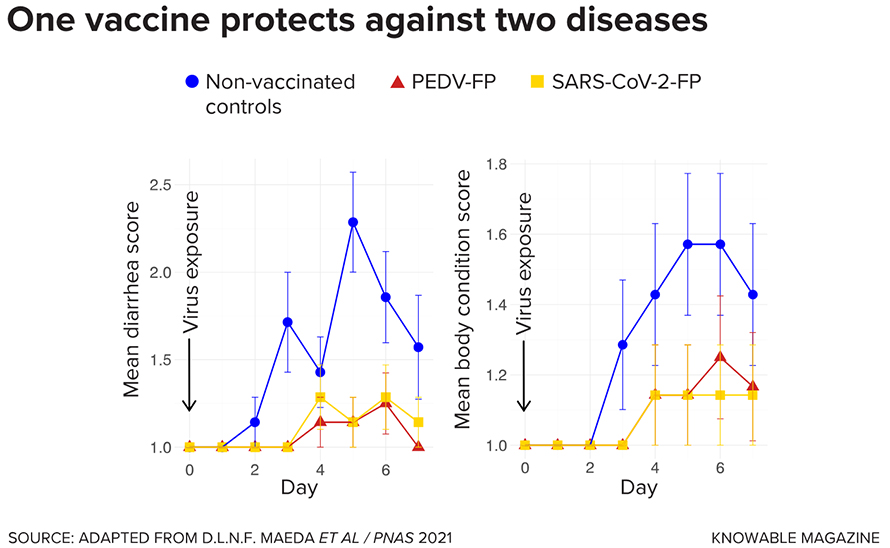
In another effort, Mohamad-Gabriel Alameh, a vaccine developer at the University of Pennsylvania, and his colleagues are developing vaccines that contain several different SARS-CoV-2 antigens, including several variants of the spike as well as some other proteins that don’t change much in a variety of coronaviruses. Having several antigens displayed on a single virus-like particle seems to activate immune cells more strongly and enhance both the potency of the immune response and the range of viruses it protects against, he says. An early test using just two antigens — the spike and another viral protein called the nucleoprotein — outperformed spike-only vaccines in hamsters, the team reported. Alameh hopes to begin testing in people in January.
Vaccine developers can also add other ingredients, known as adjuvants, to vaccines to tweak the immune system’s response, says Christopher Fox, a vaccine adjuvant developer at the Access to Advanced Health Institute in Seattle. “We’ve spent a lot of time working on adjuvant formulations that can shape the immune response to make it more potent, but also broader and more durable,” he says.
Promising as these broad-spectrum vaccines are, a lot of work remains before they’re ready for use, and many vaccines that show promise in animal tests never pan out in people. The step is such a big one that vaccine researchers sometimes talk about the “Valley of Death” between animal research and human trials, says Kim of the International Vaccine Institute. Even in the best-case scenario, the first broad-spectrum vaccine probably won’t be in clinics for another year or two, he thinks.
Self-boosting vaccines
Many vaccines, including most of those for Covid-19, require two or more doses to amp up the immune system enough to give full protection. That poses a public health problem, because in many parts of the world, people can’t or won’t get timely boosters as recommended by public health officials. This is one reason the virus has been able to evolve new variants so readily.

One solution could be to deliver the boosters at the same time as the initial dose, but in a form that will delay the release of the boosters to the appropriate time. Recently, researchers at the Massachusetts Institute of Technology reported a way to do just that.
The team encapsulates the booster doses in tiny boxes, smaller than a grain of sand, made from a material similar to that used for dissolving surgical sutures, then injects them along with the primary vaccine dose. “By changing the chemistry of these materials, you can change the degradation,” says Ana Jaklenec, a biomedical engineer at MIT who leads the team. The boxes slowly break down until, at a certain point, the lid suddenly falls off to release the contents in a single burst weeks or months after injection. Multiple boxes may be needed for each dose, but all of these can be designed to release their contents nearly simultaneously, in an unusually precise form of time-release.
Jaklenec is now testing a self-boosting Covid vaccine using her approach in lab animals, and she hopes that human trials can begin within a year or two. The approach could also be useful for other vaccines that require multiple injections.
With these and other novel vaccines on the horizon, public health officials may have a variety of options available in the next few years — nasal and broad-spectrum vaccines to reduce the spread of existing and future variants, new applications of familiar technologies like live-attenuated and bacteria-based vaccines, and self-boosting jabs for hard-to-reach people. Having multiple arrows in the vaccine quiver might give officials more flexibility in fighting an ever-changing virus, experts say. “I think,” says Bottazzi, “it’s going to have to be a combination strategy.”
This article originally appeared in Knowable Magazine, an independent journalistic endeavor from Annual Reviews.
Enjoy reading ASBMB Today?
Become a member to receive the print edition four times a year and the digital edition monthly.
Learn moreGet the latest from ASBMB Today
Enter your email address, and we’ll send you a weekly email with recent articles, interviews and more.
Latest in Industry
Industry highlights or most popular articles

How Alixorexton could transform narcolepsy treatment
A new investigational drug, alixorexton, targets the brain’s orexin system to restore wakefulness in people with narcolepsy type 1. Alkermes chemist Brian Raymer shares how molecular modeling turned a lab idea into a promising phase 3 therapy.

Inside industry postdocs
As more Ph.D. scientists look beyond academia, industry postdocs offer a new kind of training, where mentorship meets mission-driven research. Fellows at Pfizer and Genentech share how these programs prepare them to translate discovery into impact.

Black excellence in biotech: Shaping the future of an industry
This Black History Month, we highlight the impact of DEI initiatives, trailblazing scientists and industry leaders working to create a more inclusive and scientific community. Discover how you can be part of the movement.

Attend ASBMB’s career and education fair
Attending the ASBMB career and education fair is a great way to explore new opportunities, make valuable connections and gain insights into potential career paths.

Benefits of attending a large scientific conference
Researchers have a lot of choices when it comes to conferences and symposia. A large conference like the ASBMB Annual Meeting offers myriad opportunities, such as poster sessions, top research talks, social events, workshops, vendor booths and more.
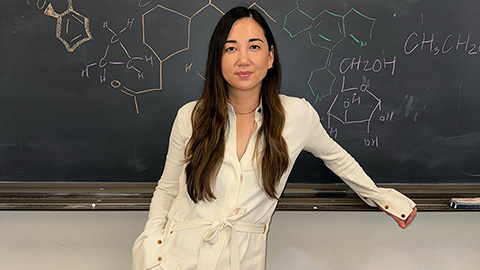
Biotech startup worms its way into therapeutics
Andrea Choe's company, Holoclara, has created an anti-inflammatory drug based on a molecule from worms.

